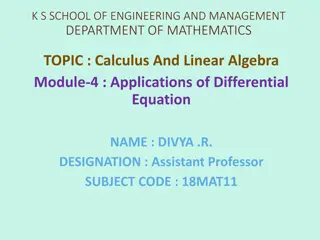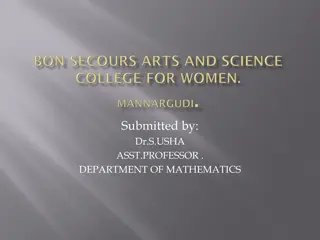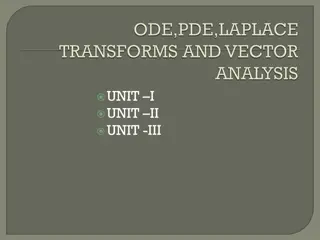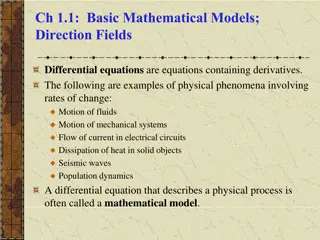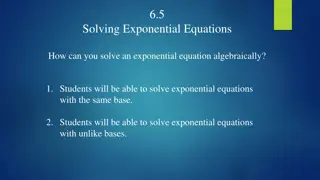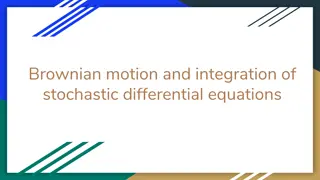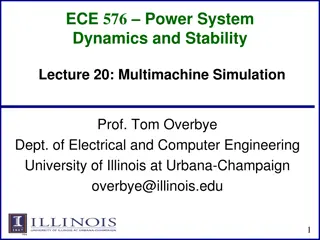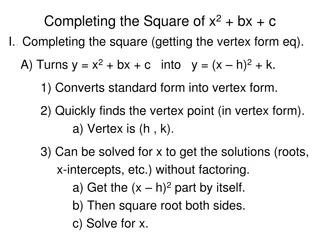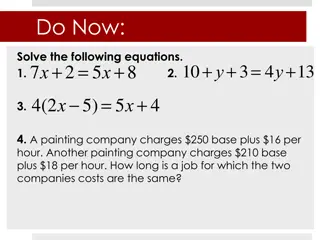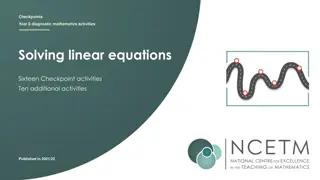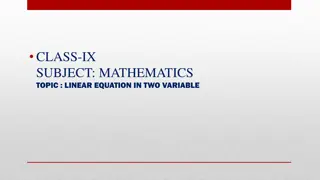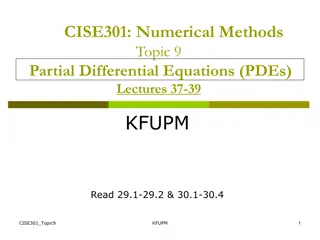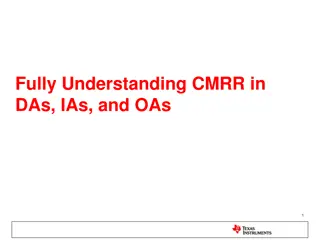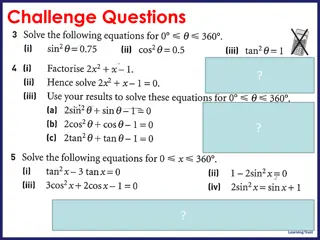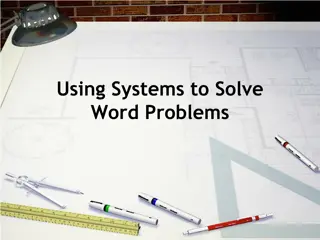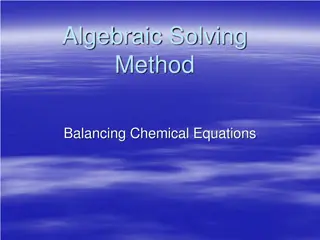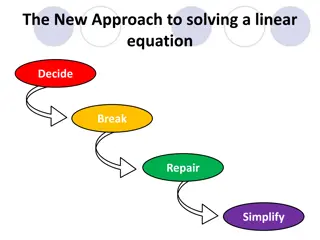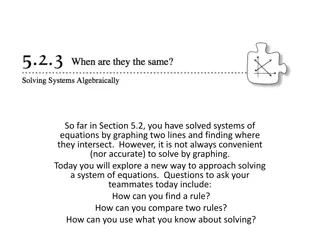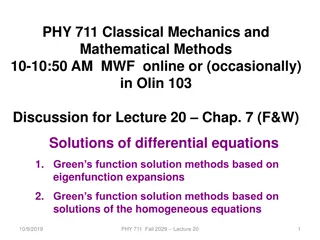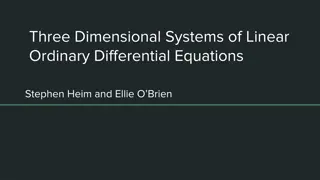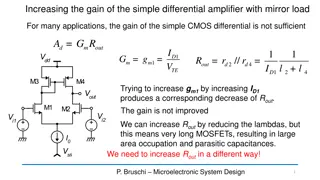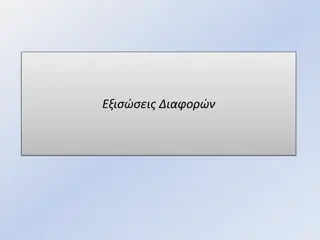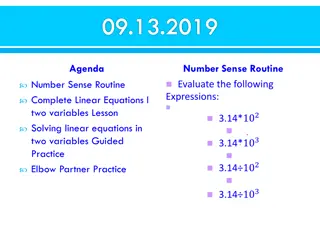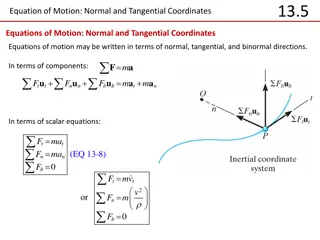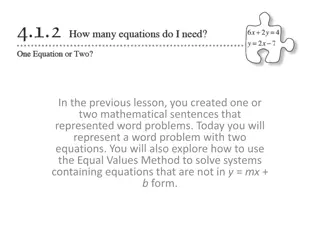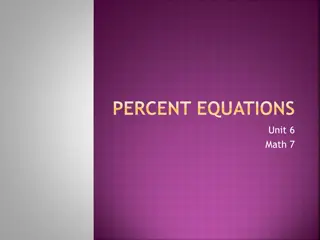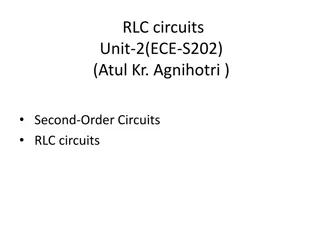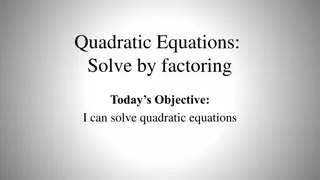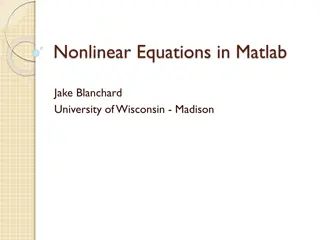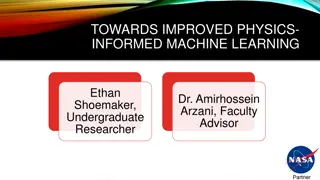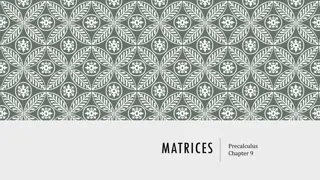Solving Differential Equations: Methods and Techniques
Learn how to solve differential equations using methods like separation of variables and sketch families of solution curves. Understand the process of finding general and particular solutions to equations, and explore a variety of exercises and examples to enhance your understanding. Master the art of integration and variable separation to tackle differential equations effectively.
Download Presentation

Please find below an Image/Link to download the presentation.
The content on the website is provided AS IS for your information and personal use only. It may not be sold, licensed, or shared on other websites without obtaining consent from the author. Download presentation by click this link. If you encounter any issues during the download, it is possible that the publisher has removed the file from their server.
E N D
Presentation Transcript
Methods in Methods in Differential Equations Differential Equations Twitter: @Owen134866 www.mathsfreeresourcelibrary.com
Prior Knowledge Check 1) Find the general solution to the differential equation ?? 3) Find: ??= ??? 3 a) 50 2??? = 3 ? = ? 1 ??+ ? 2?? 50 2? + ? b) ???4? ?? 2) Find the particular solution to the differential equation ?? given that ? = 0 when ? = 2 = 1 4?? ???4? + ? ??= ? ?, ?2= 4 ?2
Teachings for Teachings for Exercise 7A Exercise 7A
Methods in Differential Equations You need to be able to solve differential equations by separation of variables, and sketch families of solution curves ?? ??= ? ? ?(?) Divide by g(y) and multiply by dx 1 A first-order differential equation contains only first differentials ?(?) ?? = ? ? ?? Integrate both sides 1 In Pure Maths 2 you have solved these equations using the separation of variables technique ?(?)?? = ?(?)?? Once integrated, you will be left with an equation that you can rearrange to put in different forms Remember what this looks like? Remember that the +C part could be anything at this stage. The possible functions are known as a family of solution curves You can also find particular solutions if you are told information linking x and y 7A
?? ??= ? ? ?(?) Methods in Differential Equations 1 ?(?)?? = ?(?)?? ?? ??= 2 You need to be able to solve differential equations by separation of variables, and sketch families of solution curves Integrate with respect to x ? = 2? + ? y Find the general solution of the differential equation: 2 ?? ??= 2 1 Then sketch members of the family of solution curves represented by the general solution. x This is the family of solution curves for C = -2, -1, 0, 1 and 2 -1 Basically a set of possible graphs we could get for certain values of C, the constant -2 7A
?? ??= ? ? ?(?) Methods in Differential Equations 1 ?(?)?? = ?(?)?? You need to be able to solve differential equations by separation of variables, and sketch families of solution curves ?? ??= ? Multiply by y and multiply by dx ? ? ?? = ? ?? Find the general solution of the differential equation: Integrate both sides ? ?? = ? ?? ?? ??= ? Calculate ? 1 2?2= 1 2?2+ ? Then sketch members of the family of solution curves represented by the general solution. Add 1/2x 1 2?2+1 2?2= ? Multiply by 2 In this case you will need to separate the variables x and y before you can Integrate ?2+ ?2= 2? Hopefully you recognise this as the equation of a circle! ?2+ ?2= 2? As 2C is just a number, we can think of it as being the r2 part of the circle equation r2 = 2C 7A
?? ??= ? ? ?(?) Methods in Differential Equations 1 ?(?)?? = ?(?)?? ?? ??= ? You need to be able to solve differential equations by separation of variables, and sketch families of solution curves The original equation ? ?2+ ?2= 2? Find the general solution of the differential equation: y 6 ?? ??= ? ? 3 2 Then sketch members of the family of solution curves represented by the general solution. 1 x Now we have the equation we can sketch some examples from this family These curves correspond to C = 0.5, 2, 4.5 and 18 respectively (as the equation has 2C in it!) 7A
?? ??= ? ? ?(?) Methods in Differential Equations 1 ?(?)?? = ?(?)?? ?? ??= ? You need to be able to solve differential equations by separation of variables, and sketch families of solution curves ? Divide by y, multiply by dx 1 ? ?? = 1 ? ?? Integrate each side Find the general solution of the differential equation: 1 ? ?? = 1 ? ?? ?? ??= ? Calculate the integrals ? ??? = ??? + ? Add lnx Then sketch members of the family of solution curves represented by the general solution. This step is common ie) the replacing of a constant involving several letters with a single, different letter ??? + ??? = ? Use the multiplication law Take exponentials of each side (cancels the ln we will explain the modulus in a moment!) Divide by x (remember the modulus gives a positive or negative possibility) ???? = ? ?? = ?? ? = ?? Make sure it is clear when you do this! ? Replace eCwith A as eC is just a constant Remember you cannot replace a variable term such as x in this way! ? = ? ? 7A
?? ??= ? ? ?(?) Methods in Differential Equations 1 ?(?)?? = ?(?)?? ???? = ? Take exponentials of each side You need to be able to solve differential equations by separation of variables, and sketch families of solution curves ?? = ?? Why did we have to include a modulus here? This is the equation we ended up with when using the modulus ? = ? Find the general solution of the differential equation: ? If positive If negative ?? ??= ? ? =? ? = ? ? ? ? Rewrite Rewrite ? = ?? 1 ? = ?? 1 Then sketch members of the family of solution curves represented by the general solution. Differentiate Differentiate ?? ??= ?? 2 ?? ??= ?? 2 If y = A/x, A = xy If y = -A/x, A = -xy ?? ??= (??)? 2 ?? ??= ?? 1 ?? ??= ? ?? ??= ( ??)? 2 ?? ??= ?? 1 ?? ??= ? Both possibilities differentiate to give us the original function, so therefore we need to include the modulus or we would lose an answer! Group x s Group x s Rewrite Rewrite ? ? 7A
?? ??= ? ? ?(?) Methods in Differential Equations 1 ?(?)?? = ?(?)?? Increasing or decreasing the value of A (eC) will move the curves in or out! ? = ? You need to be able to solve differential equations by separation of variables, and sketch families of solution curves ? y Find the general solution of the differential equation: ?? ??= ? ? Then sketch members of the family of solution curves represented by the general solution. x 7A
?? ??= ? ? ?(?) Methods in Differential Equations 1 ?(?)?? = ?(?)?? You need to be able to solve differential equations by separation of variables, and sketch families of solution curves However, you will find that some differential equations cannot be solved by separation of variables It is possible to solve these by considering the product rule, in reverse 7A
Methods in Differential Equations ? ?? ?? = ??? ??+ ??? The product rule You can solve exact equations where one side is the exact derivative of a product, and the other side can be integrated with respect to x ?? ? ???3? Imagine we were finding: (so u = x3 and v = y) Find the general solution of the following equation: We can use the product rule above ? ?? ?? = ??? ??+ ??? ?3?? ? = ?3 ? = ? ??+ 3?2? = ???? Sub in the values to the right ?? ?? ??= 3?2 ?? ??=?? ? ???3? = ?3?? ?? In this example you will not be able to separate the variables easily, if at all! ??+ 3?2? Notice that d/dx(x3y) is equivalent to the left side of the original equation You can use a pattern from the product rule however This means we can replace it! ?3?? ??+ 3?2? = ???? ? ???3? = ???? Replace the left hand side with equivalent expression 7A
Methods in Differential Equations You can solve exact equations where one side is the exact derivative of a product, and the other side can be integrated with respect to x ?3?? ??+ 3?2? = ???? ? ???3? = ???? Replace the left hand side with equivalent expression Take integrals of each side On the left side, the integral and differential cancel each other On the right side calculate the integral of sinx Find the general solution of the following equation: ? ???3??? = ?????? ?3?? ?3? = ???? + ? ??+ 3?2? = ???? Divide by x3 ? = 1 ?3???? +1 ?3? In this example you will not be able to separate the variables easily, if at all! Other forms of this answer, such as the one below, are also fine! You can use a pattern from the product rule however ? = ???? + ? ?3 7A
Methods in Differential Equations You can solve exact equations where one side is the exact derivative of a product, and the other side can be integrated with respect to x General pattern differentiates to this function of x This function of x You can use a general pattern to see whether this is doable. It is possible if the conditions to the right are met. ?3?? ??+ 3?2? = ???? If the conditions are met, you can change the expression on the left side to: differentiates to this function of y (with respect to x) This function of y ? ?? ? ? ???????? ?? ? (? ? ???????? ?? ?) To put this using proper mathematical notation 7A
? ??? ? ?(?) ? ? ? (?) + ? ? ?(?) Methods in Differential Equations General pattern You can solve exact equations where one side is the exact derivative of a product, and the other side can be integrated with respect to x ? ? ? (?) + ? ? ?(?) Using mathematical notation Can be written as: ? ??? ? ?(?) The most common one you ll see is: ?? ??+ ? ? ? Can be written as: ? ? ? ??? ? ? 7A
? ??? ? ?(?) ? ? ? (?) + ? ? ?(?) Methods in Differential Equations 6?2??? You can solve exact equations where one side is the exact derivative of a product, and the other side can be integrated with respect to x ??+ 6??2= ???2? Imagine the first part was split up we can see the pattern will work! Rewrite the left side using the rule you have seen (3?2)(2?)?? ??+ 6??2= ???2? Find the general solution of the following differential equation: ? ??3?2?2= ???2? 6?2??? Take integrals of each side ??+ 6??2= ???2? ? ??3?2?2?? = ???2? ?? At a first glance it might look like the pattern will not work here Calculate 3?2?2= ???? + ? Divide by 3x2 6x2 does not differentiate to 6x, and y2 does not differentiate to ydy/dx ?2=???? + ? 3?2 Square root (or just leave as it is with y2!) However, if we split up part of the equation, we can see that the pattern does work ???? + ? 3?2 ? = 7A







